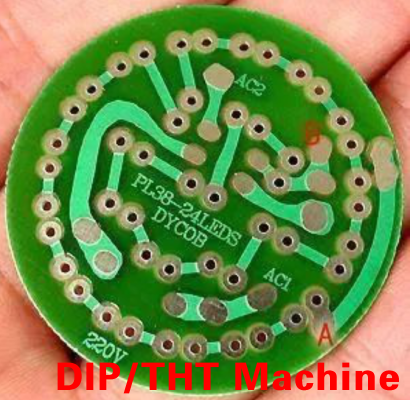Types and design standards of pads in PCB design 2
From: Author:Mark Hardy Publish time:2021-09-09 13:59 Clicks:0
Design standards for pads in PCB design
1. The shape and size design standard of PCB pad
1. The minimum single side of all pads is not less than 0.25mm, and the maximum diameter of the entire pad is not more than 3 times the component aperture.
2. Try to ensure that the distance between the edges of the two pads is greater than 0.4mm.
3. In the case of dense wiring, it is recommended to use oval and oblong connecting plates. The diameter or minimum width of the single-sided board pad is 1.6mm; the weak-current circuit pad of the double-sided board only needs to add 0.5mm to the hole diameter. Too large the pad will easily cause unnecessary continuous soldering. The diameter of the hole exceeds 1.2mm or the diameter of the pad. The pads over 3.0mm should be designed as diamond or quincunx pads.
4. For plug-in components, in order to avoid the phenomenon of copper foil breaking during welding, and the single-sided connecting plate should be completely covered with copper foil; the minimum requirement for double-sided panels should be filled with teardrops.
I.C.T is a manufacturer of SMT machines. It mainly provides customers with SMT production lines including SMT Stencil Printers, Pick and place machines, Reflow Oven, AOI Machine, Wave Soldering Machine and PCB Handling Machine etc. I.C.T has more than 25 researches on SMT and DIP technology, for the world Customers provide SMT total solutions. There are successful cases of SMT technICal team in Asia, Europe, AmerICa, AfrICa, and Australia.
I.C.T provide SMT solutions at various stages according to the different needs of customers. I.C.T is not only a provider of SMT equipment and technology, but also is the customer's escort in the field of SMT and DIP.
Welcome more people to discuss with us about SMT technologies and solutions, please contact us for more information:
Tel: +86 13670124230 (WhatsApp/Skype/WeChat)
Email: etaSMT@foxmail.com
5. All machine insert parts need to be designed as drip pads along the bent leg direction to ensure full solder joints at the bent leg.
6. The pads on the large-area copper skin should be chrysanthemum-shaped pads, which should not be soldered. If there is a large area of ground and power lines on the PCB (with an area of more than 500 square millimeters), the window should be partially opened or designed to fill the grid.
2. PCB pad via size standard
The inner hole of the pad is generally not less than 0.6mm, because the hole smaller than 0.6mm is not easy to process when punching the die. Usually, the diameter of the metal pin plus 0.2mm is used as the inner hole diameter of the pad, such as the diameter of the metal pin of the resistor When it is 0.5mm, the diameter of the inner hole of the pad corresponds to 0.7mm, and the diameter of the pad depends on the diameter of the inner hole.

Three, the reliability design points of PCB pads
1. Symmetry. To ensure the balance of the surface tension of the molten solder, the pads at both ends must be symmetrical.
2. Pad spacing. Too large or too small pad spacing will cause soldering defects. Therefore, ensure that the spacing between component ends or pins and pads is appropriate.
3. The remaining size of the pad. The remaining size of the component end or pin and the pad after the overlap must ensure that the solder joint can form a meniscus.
4. The width of the pad should be basically the same as the width of the component tip or pin.
Fourth, PCB manufacturing process requirements for pads
1. Test points should be added if the two ends of the chip components are not connected to the plug-in components. The diameter of the test point is equal to or greater than 1.8mm to facilitate the on-line tester test.
2. If the IC foot pads with dense pin spacing are not connected to the hand plug-in pads, test pads need to be added. For chip ICs, the test points cannot be placed in the chip IC silk screen. The diameter of the test point is equal to or greater than 1.8mm to facilitate online tester testing.
3. If the distance between the pads is less than 0.4mm, white oil must be applied to reduce continuous soldering when the wave crest is exceeded.
4. The two ends and ends of the SMD component should be designed with lead-tin. The lead-tin width is recommended to use 0.5mm wire, and the length is generally 2 or 3mm.
5. If there are hand-soldering components on the single panel, the tin bath should be removed, the direction is opposite to the tin passing direction, and the width of the viewing hole is 0.3MM to 1.0MM.
6. The spacing and size of the conductive rubber buttons should be consistent with the actual conductive rubber buttons. The PCB board connected to this should be designed as a gold finger, and the corresponding gold plating thickness should be specified.
7. The size and spacing of the pad should be basically the same as the size of the patch component.
LED Tube Assembly Line, LED Light Assembly Line, Stencil Printing Machine, Paste Printer, E10 SMD Reflow Oven, 7 Level Reflow Soldering Oven, Wave Soldering Equipment, Desktop SMT SMD Manual Machine, SMT PCB Screw Machine LED, SMT Machine Pick And Place, SMT Component Vacuum Sealing Machine, Fabrication SMT Machine Structure Frame, Terminal Plug In SMT Machine, PCB Soldering Robot, Automatic Soldering Robot 5 Axis, Solar Cell Solder Robot, Soldering Robot Price, Pv Module Solder Robot, PCB Soldering Robot Automatic, Robotic Soldering Machine


